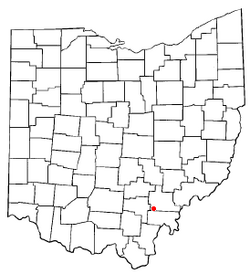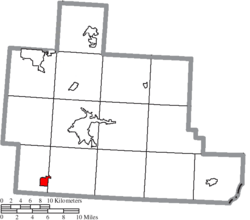Albany, Ohio facts for kids
Quick facts for kids
Albany, Ohio
|
|
|---|---|
|
Village
|
|

A view of Albany with State Route 681 in the background
|
|

Location of Albany, Ohio
|
|

Location of Albany in Athens County
|
|
| Country | United States |
| State | Ohio |
| County | Athens |
| Area | |
| • Total | 1.35 sq mi (3.49 km2) |
| • Land | 1.33 sq mi (3.45 km2) |
| • Water | 0.01 sq mi (0.04 km2) |
| Elevation | 745 ft (227 m) |
| Population
(2020)
|
|
| • Total | 917 |
| • Estimate
(2023)
|
924 |
| • Density | 688.44/sq mi (265.72/km2) |
| Time zone | UTC-5 (Eastern (EST)) |
| • Summer (DST) | UTC-4 (EDT) |
| ZIP code |
45710
|
| Area code(s) | 740 |
| FIPS code | 39-01042 |
| GNIS feature ID | 2397922 |
| Website | www.albanyoh.org |
Albany is a small village located in Athens County, Ohio, in the United States. In 2020, about 917 people lived there.
Contents
Geography
Albany covers a total area of about 1.35 square miles (3.49 square kilometers). Most of this area is land, with a very small part being water.
History of Albany
Albany was first planned out around 1832. It officially became a village in 1842.
Albany and the Underground Railroad
This small village became an important stop on the Underground Railroad. This was a secret network that helped enslaved people escape to freedom. People escaping slavery could travel up the Hocking River from the Ohio River to reach Albany.
Many free African Americans also moved to Albany in the mid-1800s. They came from the southern states to find a better life and escape unfair treatment. By 1860, the number of Black residents in the area grew to 174. Many of these new residents had come from states like Virginia.
Education for African Americans
In Ohio during this time, it was hard for African American children to go to public schools. However, Albany offered special private schools that welcomed them. This was not common in most other parts of the state.
Lewis Academy
In 1848, William S. Lewis started the Lewis Academy. This school was special because it accepted students of all races and genders. Lewis was inspired by the open-minded ideas of Oberlin College, where he had studied.
Albany Manual Labor University
In 1850, a group took over Lewis Academy and changed its name to the Albany Manual Labor Academy. Later, it became the Albany Manual Labor University (AMLU). This school continued to welcome students of all backgrounds. People who owned slaves were not allowed to be part of the school's ownership.
Students who needed help paying for school could borrow money. They could also work two hours a day to earn their tuition. They might work on the school's farm, at its saw-mill, or by making bricks.
The school's main goal was to fight against unfair differences based on race or social class. It wanted to show that everyone deserved a chance to learn. The school's rules even required that one woman and one African American person be on its board of directors. Philip Clay, a successful shoemaker and former enslaved person from Virginia, was one of the first Black board members.
Famous people who fought against slavery, called abolitionists, also helped the school. These included John Brown, a local merchant, and Salmon P. Chase. Chase later became a U.S. Senator and a Supreme Court Chief Justice.
AMLU had its most students in 1857, with 284 learners. But the school faced money problems. In 1862, a church group called Albany's Free Will Baptists took over. Sadly, they stopped allowing African American students. The start of the Civil War also caused fewer students to attend, and the school eventually closed.
Albany Enterprise Academy
To make sure their children could still get an education, African Americans in the area started their own school. In 1862, they founded the private Albany Enterprise Academy. This was the first school in Athens County created only by and for African Americans. It stayed open until 1886.
Important Black community leaders helped start this school. These included Thomas Jefferson Furguson, who helped start the Ohio Colored Teacher's Association. A two-story building was built, and the school opened in 1864 with 49 students.
In 1864, the school advertised itself, saying it would be owned and run by Black people. They believed it was time for Black people to show their own intelligence and grow.
The Enterprise Academy had over 100 students in its early years. This was about the same number of students as Ohio University had at the time. As more students joined, a second building was added in 1870 for a girls' dormitory.
By the late 1870s, many Black families moved to bigger cities for work. Also, local public schools started allowing students of all races. Because of these changes, fewer students attended the Enterprise Academy, and it closed in 1886.
The Great Fire of 1911
In the early morning of May 2, 1911, a terrible fire hit downtown Albany. It destroyed an entire block of buildings. Six stores, a hotel, and several homes burned down. Strong winds made the fire spread quickly through the wooden buildings.
In just about an hour and a half, almost all the buildings on one side of Main Street were gone. Only the post office and telephone building were saved. The fire was so hot that buildings across the street were also in danger, and many windows broke. Many people worked for hours to stop the fire from spreading further.
Just 14 years before, the other side of this same block had also burned. Most of those buildings were rebuilt using brick, which is much safer.
Population Information
| Historical population | |||
|---|---|---|---|
| Census | Pop. | %± | |
| 1870 | 480 | — | |
| 1880 | 469 | −2.3% | |
| 1890 | 471 | 0.4% | |
| 1900 | 548 | 16.3% | |
| 1910 | 546 | −0.4% | |
| 1920 | 465 | −14.8% | |
| 1930 | 471 | 1.3% | |
| 1940 | 551 | 17.0% | |
| 1950 | 525 | −4.7% | |
| 1960 | 629 | 19.8% | |
| 1970 | 899 | 42.9% | |
| 1980 | 905 | 0.7% | |
| 1990 | 795 | −12.2% | |
| 2000 | 808 | 1.6% | |
| 2010 | 828 | 2.5% | |
| 2020 | 917 | 10.7% | |
| 2023 (est.) | 924 | 11.6% | |
| U.S. Decennial Census | |||
2020 Census Details
In 2020, Albany had 917 people living in 360 households. About 212 of these were families. Most homes (74.2%) were owned by the people living in them.
The people living in Albany were mostly White (97.8%). A small number were African American (1.0%) or from other races (1.2%). The average income for a household was $26,333.
About 26.1% of households had children under 18. The average household size was 2.22 people. The average family size was 2.91 people.
The average age of people in Albany was 42.4 years. About 19.4% of residents were under 18. About 57.3% of the population was female, and 42.7% was male.
Education
Public schools in Albany are part of the Alexander Local School District. Students attend:
- Alexander Elementary School (for grades Pre-Kindergarten to 5)
- Alexander Middle School (for grades 6 to 8)
- Alexander High School (for grades 9 to 12)
Albany also has a public library. It is a branch of the Athens County Public Libraries.
See also
 In Spanish: Albany (Ohio) para niños
In Spanish: Albany (Ohio) para niños


